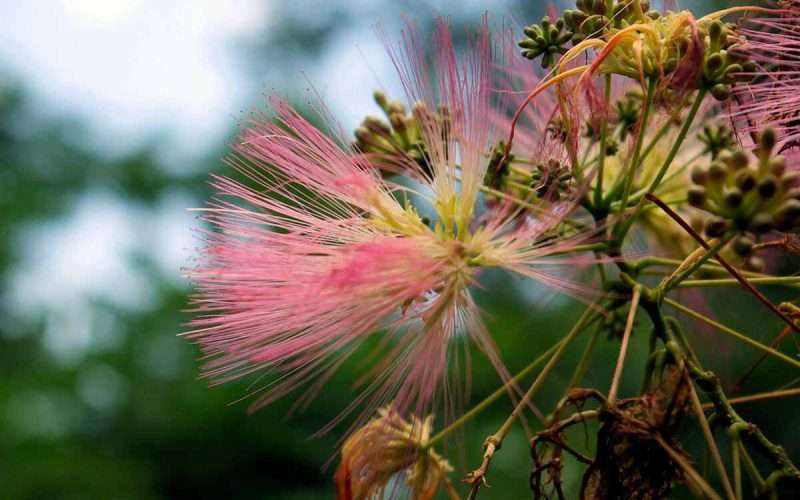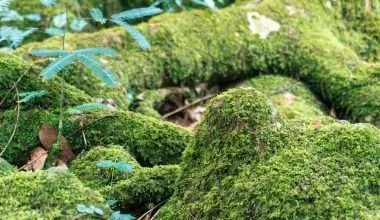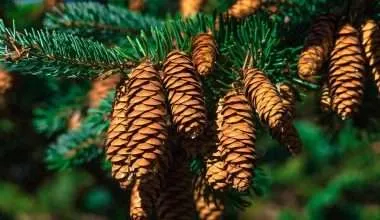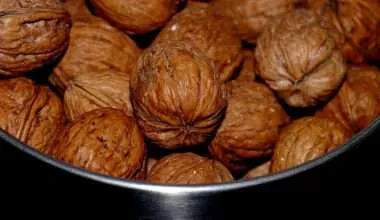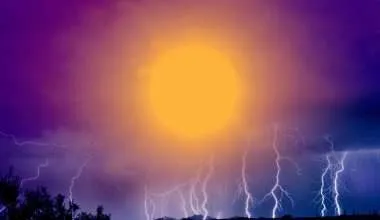Table of Contents Show
The mimosa tree is a delightful spectacle of bright pink flowers. The delicate pink blooms resemble starbursts and grow during the summers in small clusters.
However, do not get deceived by their appearance, as they are hopelessly short-lived, target for pests, and will create a mess in your yard.
If you are considering growing mimosa trees, you should know everything about them before bringing them home. Here are some important mimosa tree facts, tips to grow them, and the pros and cons of keeping them.
Mimosa Tree Facts
First, let’s discuss the many names of this complicated tree. The Albizia julibrissin is the genus name of the mimosa tree and belongs to the Fabaceae family. It is called the Chinese silk tree, pink silk tree, Lenkoran tree, and Persian silk tree.
Mimosa trees are fast-growing flowering that may grow up to fifty-two feet. Their fern-like leaves resemble the leaves of palm trees and close at night or during the rainy season.
The tree became popular for its texture and for its stunning looks, as its leaves provide an aesthetic background for the colorful silk-like flowers.
They were initially introduced as ornamental trees, but they escaped cultivation. Now people grow them in various areas over the southeastern U.S. However, it competes with native tree species for water, nutrients, and light.
Many of the Mimosa tree cultivars are popular, such as Ishii Weeping and Summer Chocolate.
Where Does The Mimosa Tree Originate From?
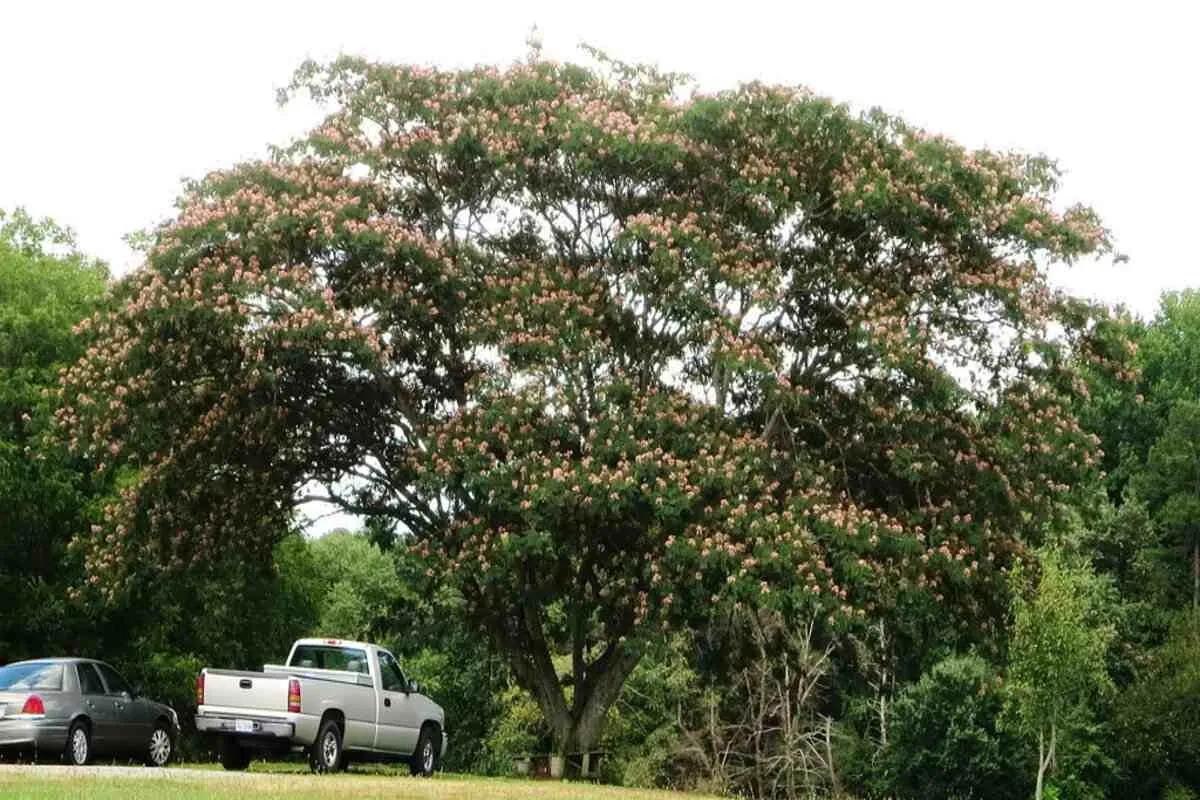
The Mimosa tree is native to Asia and the Middle East. It is said to be brought to the United States in 1785 by Andre Michaux, a famous French botanist. Michaux planted Mimosas in his botanic garden in South Carolina. The plant soon grew into a flat-topped and vase-shaped tree, reaching a height of 40 feet with colorful flowers.
It grows fast and can get up to five feet tall in one growing season. The mimosa tree leaves are particularly separated, wth each being over 5 to 8 inches in length and 3 to 4 inches in width, alternating along the tree’s stems.
When do mimosa trees bloom?
The mimosa trees bloom in the depths of summer when it is adorned by lovely flowers. They start to bloom in early May and go on till July. While they can withstand cold weather and less sunlight, their foliage becomes deep green in the sunshine and warm weather conditions.
Where do mimosa trees grow?
While being native to Asia, they prefer warmer climates. They are now growing in popularity (or unpopularity) over the world and can withstand cold spells.
It grows well in the USDA Plant Hardiness Zones 6 to 10 in the subtropical and tropical climates of the lower latitude areas. It lives in dry to wet areas and spreads along stream banks.
They usually grow in backyards, along the roadside and streams, or a river, and in woodlots, clearings, and forests. It is cultivated as an indoor plant in mild climates and outdoors in tropical regions. However, outdoor cultivation results in a weedy invasion in most places, such as Hawaii.
Mimosa tree seeds
They produce seed pods, which contain about five to ten seeds. These seeds have a neurotoxin in them, which is harmful to livestock and other pets if ingested. They are alkaline and cause breathing difficulties.
The seeds can remain stagnant for a long time and are usually spread out close to the plant. They are also distributed by wind or water. Especially if the tree is grown alongside a river, it can travel extended distances before growing.
Benefits of Mimosa Trees
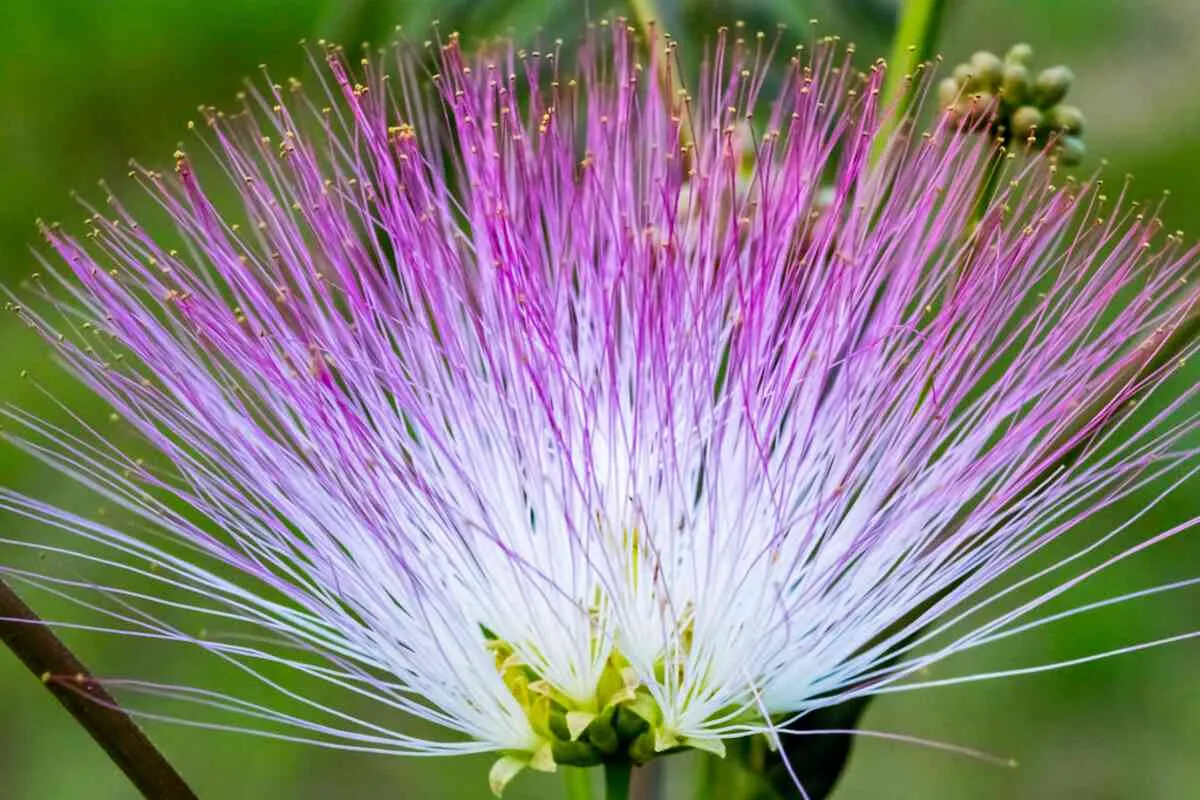
The tree is still popular in many countries. With proper care of mimosa trees, they can stay problem-free. Here are some of the pros of growing them.
1. The beauty of the tree
One of the biggest reasons why gardeners grow mimosa trees is because seeing their pretty flowers bloom can be quite pleasing.
They produce a variety of wonderful blooms in various shades from red to deep pink, and baby pink to white.
The Summer Chocolate cultivar produces bronze and purple leaves which can be a majestic sight.
The fragrant pink threads of flowers and the sweet nectar attract hummingbirds, honeybees, and butterflies, which creates a beautiful wildlife scene.
2. They provide shade
Mimosa trees create a warm and shaded area at the front of properties or in a yard.
The foliage of Mimosa is unlike any other tree due to the shape of its leaves. They create a light-filtering effect and filter light on shaded areas. Therefore, it is popularly used as a patio or terrace tree for the shade.
The tree can grow from small to medium and is deciduous in nature, which means that it loses its leaves when it stays still. Thus, it helps create a warm environment during the daytime even during cold winter days.
3. Easy to grow
One of the big benefits of a mimosa tree is that they are easy to grow in all kinds of weather conditions and soil types.
They can survive in partial or full sun and are drought-resistant plants. Mimosa trees are resistant to drought and can tolerate low rainfall. However, they produce fuller foliage in moist conditions, that resemble their native conditions.
They can adapt to any land and adjust to any moist soil. This is the reason why we can see them growing on every country road and highway in South America.
Cons of growing Mimosa trees
By looks, Mimosa trees look like treasure. However, due to their many problems, they are called ‘trash trees’ by horticulturists and gardeners.
1. They create a mess
Growing plants and trees should be calming and rewarding, but that’s not the case with mimosa trees. They can be extremely messy and do not live for long.
They are fast-growing and can fill out large spaces across any landscape in a short time. and hinder other shrubs and grasses from getting the sun. They keep growing even in winters after their leave has fallen. The seed pods also create a mess and litter the ground.
You will find seed pods everywhere, in cracks of your pavement, in between other bushes, or even in gas or water tanks. They germinate everywhere.
The seeds germinate at a fast speed and require regular cleaning up. If the tree is the main attraction of your house, you will face a major cleaning issue, especially during the flowering season.
2. Short life span
Imagine taking care of your mimosa tree, only to see it die. The mimosa tree’s wood is weak and brittle and the branches can break easily. Its breakage and fragility of wood cause it to have a short life.
The mimosa tree also attracts vascular wilt and webworms, which can damage the branches, causing the structure of the tree to crumble.
The majority of its root system grows from its roots of two or three large-diameter, that emerge from the foundation of the trunk. They eventually raise patios and walks as they grow huge in diameter, which makes for inadequate transplanting success because the tree only keeps growing in size.
When the tree grows massive, it can create dense thickets, preventing other trees and plants from their proper growth.
3. Pests and diseases
While the mimosa is a hardy tree species, it can get affected by a vascular fungal disease called Mimosa Wilt that hinders the tree’s growth.
It is a soil-borne fungus that attacks the root system of trees. The leaves of the affected tree will become yellow and wither before the end of summer, disrupting the process of flowering. The tree will die quickly after the fungus spreads. However, sometimes it affects branches first.
The diseased tree will be difficult to take care of and will be having liquid oozing from the cracks of its trunks. A balanced fertilizer can prevent the mimosa tree from developing the ailment. Proper maintenance such as removing dead wood and frequent watering can also cause it to live longer.
Are Mimosa Trees Invasive?
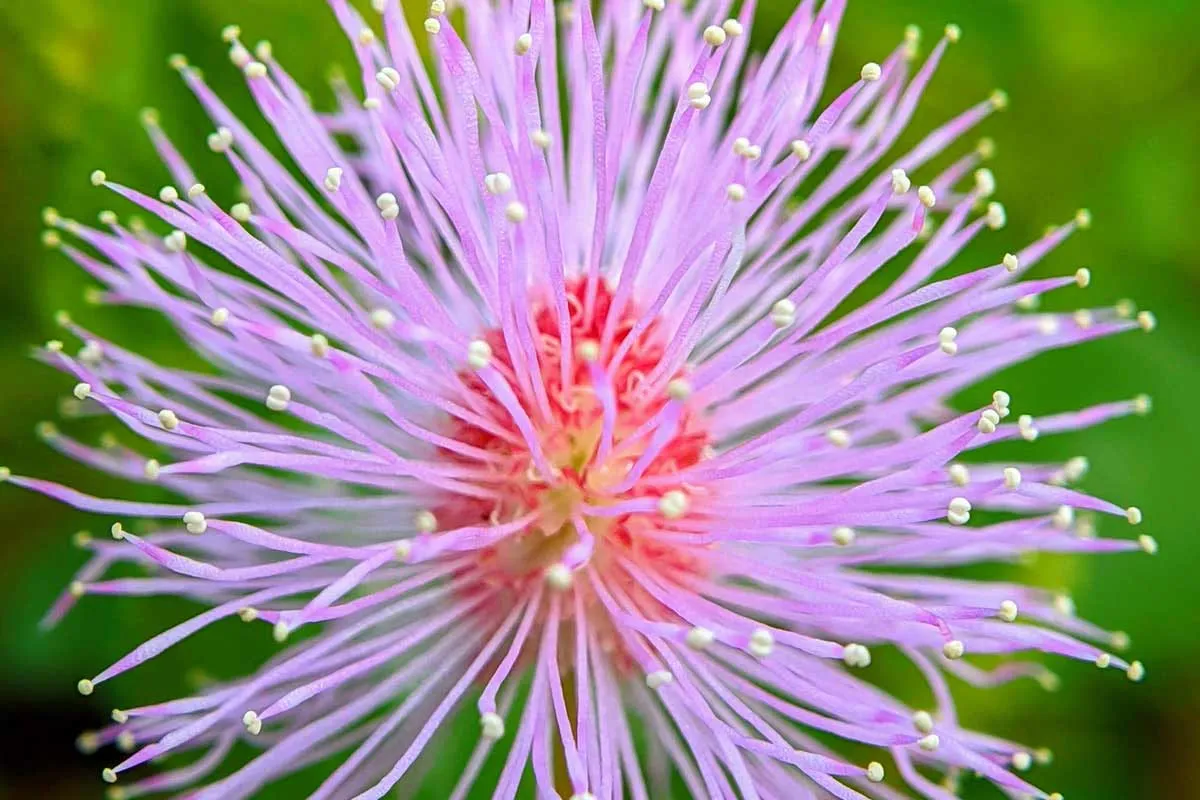
The Mimosa Tree has been called an invasive species in many parts of the world, including Japan and some states of the U.S. By invasive, it means that the mimosa tree is aggressive and non-native and has the ability to cause environmental harm to animals and native plants and trees by displacing them.
Animals that are dependent on native tree food resources will also struggle due to mimosa trees. Songbirds look for caterpillars and other insects that are usually found on native trees for food and to rear their young babies.
The mimosa tree’s invasiveness causes a scarcity of food resources for the animals as there would be fewer native trees left due to the mimosa trees.
The mimosa trees produce prolifically and their seeds grow rapidly, which is some of the reasons for their problematic nature and as is true for most invasive species. Their seedpods occur at the end of summer and seeds start to sprout. Their seeds are rigid and can stay stagnant for years.
The mimosa tree’s dense stands decrease the availability of sunlight for other species, leading to a disruption in the ecosystem and wildlife habitat.
However, a non-seed producing Mimosa cultivar is being cultivated by researchers so people to enjoy the beauty and benefits of mimosa trees without worrying about the risks involved.
Planting Mimosa Trees
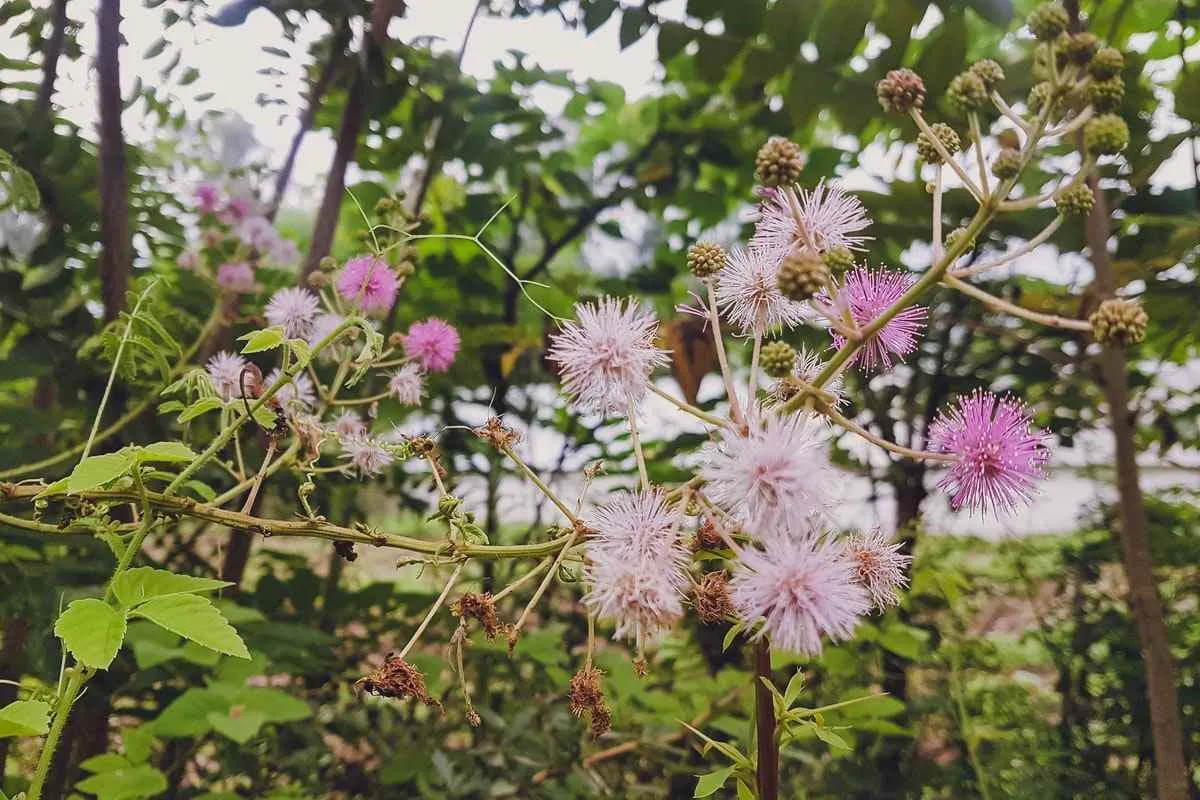
After you are aware of all the facts, advantages, and disadvantages of growing mimosa trees, you can decide accordingly. If you still want to grow them, make sure to give them proper care.
Although the cons of keeping a mimosa outweigh the pros, you can still grow them in an area where there are fewer native trees and plants to not disrupt the ecosystem.
It can be used alongside driveways or entryways as they are best used for their ornamental beauty. The uniformity of its shape can mean that you can place most of these species together to create a symmetrical look.
Sunlight: Plant your mimosa tree in an that gets full exposure to the sun. Although, indirect sunlight can be helpful in the dry climate areas to keep the moisture of the tree retained.
Soil: Mimosa is not restricted to any soil type. However, it does not tolerate salt that well and thrives in alkaline or acidic soil. They also love well-drained and moist soil.
Water: The tree needs a minimum of one inch of water to survive, in the form of irrigation or rainfall. However, it does well in areas with no water and a drought-like environment.
Pruning: You should prune your mimosa tree in winters when the tree is stagnant and there are no leaves falling. However, you should start pruning it after three years of age. Also regularly remove the diseased or dead wood to maintain its health.
Mimosa trees care
There are a number of problem areas of the mimosa trees. However, with proper care, you can prevent some, if not all, of them.
Firstly, there is a huge issue of webworms destroying the leaves and the caterpillars eating the leaves. The solution is to prune and get rid of the damaged leaves affected by the webbing.
Rake the leaf debris and replace the sawdust or compost at the bottom of the tree every fall season. You can also spray the tree with horticultural oil during early March as this would suffocate the forming pests. You can also use Thuricide, Dipel, or Javelin in case of a serious infestation.
For the problem of wilting leaves and dying branches, you can keep them clean and free from pests. However, there is no remedy for soilborne as they enter the tree through its roots. You can remove the diseased trees and be sure not to plant mimosa trees in the same place.
I hope that you are now well aware of all there is to know about mimosa trees. They can be beautiful creatures, but bring a plethora of issues with them. So make sure you can handle those problems before committing to growing one.
